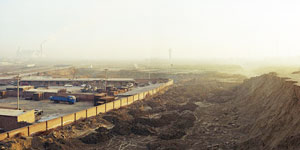 Beijing waste crisis: Gao'antun Waste Incineration and Power Generation Plant.
Beijing waste crisis: Gao'antun Waste Incineration and Power Generation Plant. The capital Dhaka with its 360 square kilometre area and the population size of 16 million is one of the most densely populated cities in the world. For such a large population, the city area is small and inadequate. Besides the existing population, continuous migration of people from rural areas has created numerous problems for the city, viz., unsustainable development and environmental pollution. One of the major environmental hazards facing the city relates to managing waste and garbage.
The large population of the city generates a huge volume of municipal solid wastes (MSWs) every day. The total MSW generation rate of Dhaka city is 5,000 tonnes per day, while per family it is 2.33 kg and per capita 0.56 kg. But the city's waste collection efficiency is about 60 per cent, of which approximately 80 to 85 per cent of the collected wastes go to dumping yards and only 15 per cent are recycled either mechanically or biologically.
Currently, there are eight dumping yards including two sanitary landfills at Matuail and Amin Bazar. But the six dumping yards remain almost unutilised; these are used only if Matuail and Amin Bazar landfill sites become inaccessible during the rainy season. Lately, Matuail is the main MSW dumping site of Dhaka city. Besides the two municipal corporations, there are some other agencies that collect and recycle wastes for resource recovery, such as plastic, paper and metals etc. Moreover, some non-governmental organisations (NGOs) like Waste Concern are making compost fertiliser from organic wastes.
Globally, MSW generation rate is increasing rapidly due to the increasing population and economic growth. Industrialised countries generate higher quantity of wastes per capita than developing countries, but the cumulative volume of wastes in developing countries is significant due to their large population size. Developed countries like Japan, Singapore, United States, and the European countries use Waste to Energy (WtE) technology for large volume of waste disposal. Similarly, there are some developing countries such as Malaysia, India, Brazil and some African countries that are producing electricity from solid wastes and biomass either through incineration or anaerobic digestion. As a result, MSW is considered as a potential source of renewable energy worldwide.
China, a country with a population of 1.35 billion, creates more than 360 million tonnes of domestic waste each year, of which 156,000 tonnes are treated by using 166 incineration facilities to generate 2,600MW energy per day. Currently, through incineration about 15 to 20 per cent of the total MSW is disposed in China. The Gaoantun plant in Beijing alone treats 530,000 tonnes of garbage per year generating 200 million kilowatt-hours of electricity, 160 million of which reach the national grid. The profits of power generation from wastes are higher than for landfill or fertiliser, and the profit ratio is higher than many other industries.
In Japan, the main disposal technology is incineration. However, it generates on a yearly basis about 65 million tonnes of wastes and 40 million tonnes are treated thermally. The rest is being recycled and/or composted. Singapore also disposes its daily generated wastes through thermal treatment. On the other hand, the United States generates on a yearly basis around 387 million tonnes of MSW. On an average, about 8.0 per cent of the MSW is destined for WtE and around 25 per cent is recycled or composted. The remainder 63 per cent is landfilled.
By using incineration facilities, European countries also generate electricity and the share is considerable in their total renewable energy production. For example, in Denmark it is 18.5 per cent, Germany 7.3 per cent, Estonia 12.0 per cent, Italy 8.4 per cent, Latvia 30.4 per cent, Lithuania 16.6 per cent, Austria 17.3 per cent, Portugal 12.4 per cent, Romania 11.8 per cent, Slovenia 9.7 per cent, Finland 25.8 per cent and Sweden 22.3 per cent. 7.7 per cent renewable energy in EU countries comes from biomass and renewable wastes.
Lately, Bangladesh government is encouraging resource recovery from MSW and has already provided a guideline manual. As a result, several national and international NGOs are working on MSW collection and recycling as well as providing training to informal recycling sectors to promote their activities with the collaboration of the government. Thereby, major portion of the recyclable wastes is being recycled in Dhaka by informal sectors and some NGOs are also treating wastes to produce organic fertiliser. But composting is a slow process; hence, it can't recover the entire volume of daily generated wastes.
The most appropriate option for Dhaka city's waste disposal is incineration along with energy recovery. It can thus partially meet the local energy demand as well as save disposal cost. Moreover, by producing renewable energy, it can help maintain sustainable environment.
© 2024 - All Rights with The Financial Express
